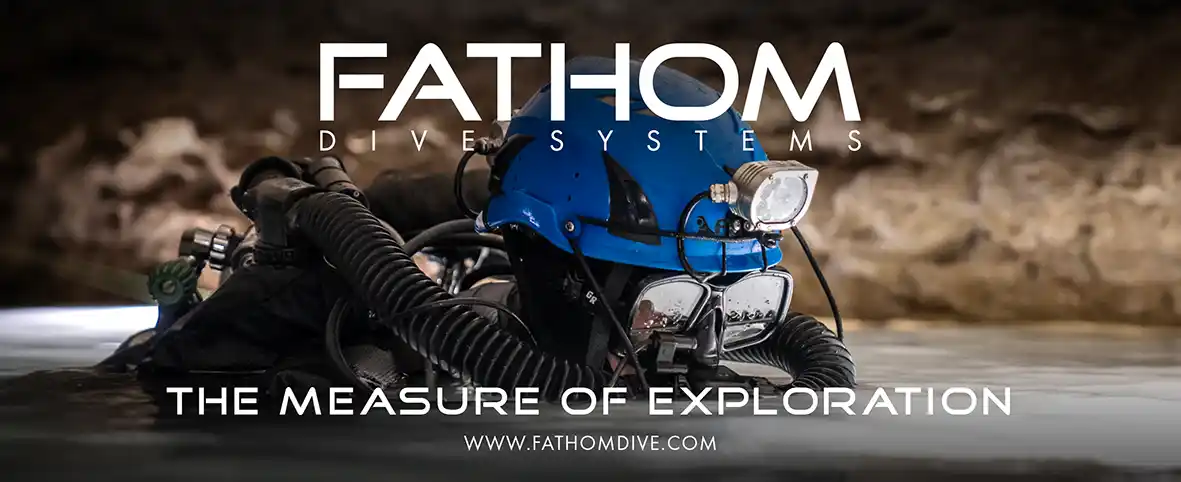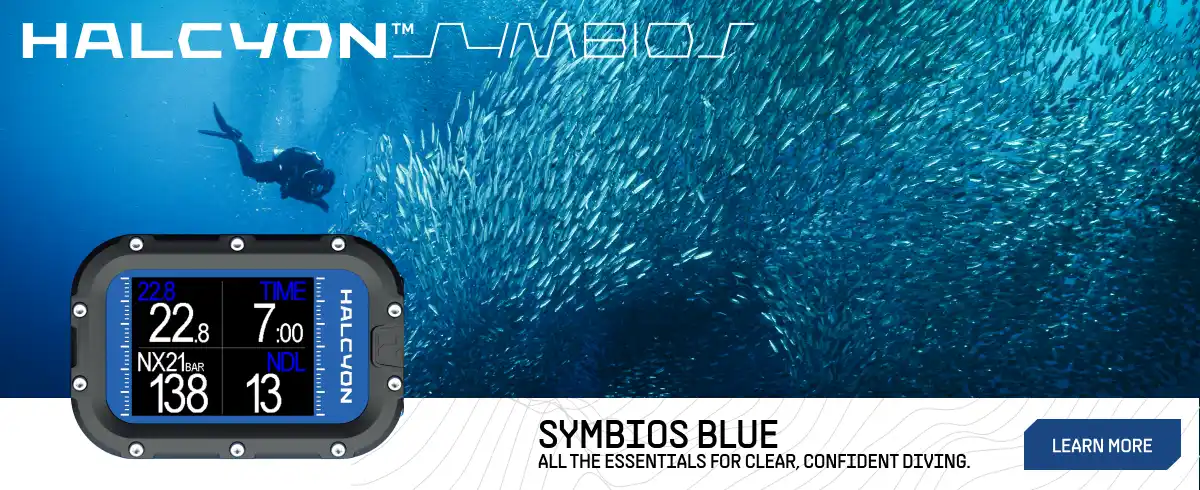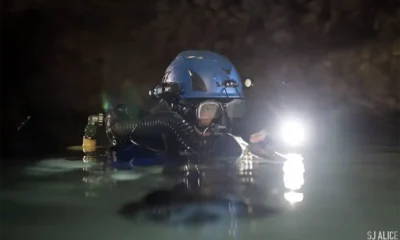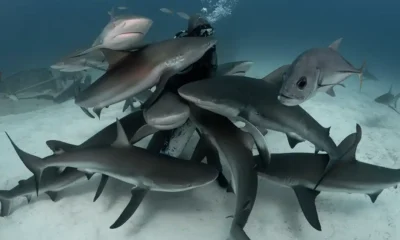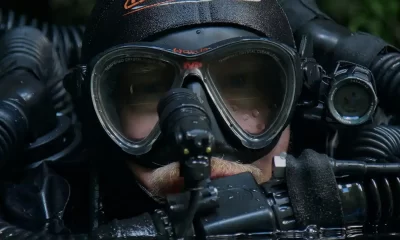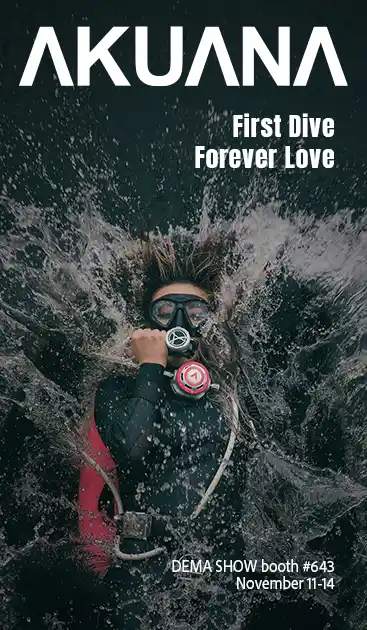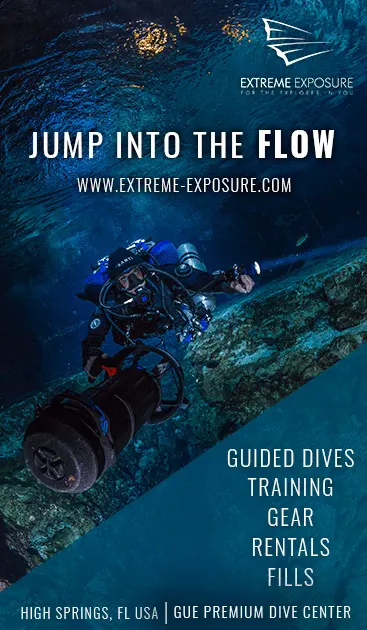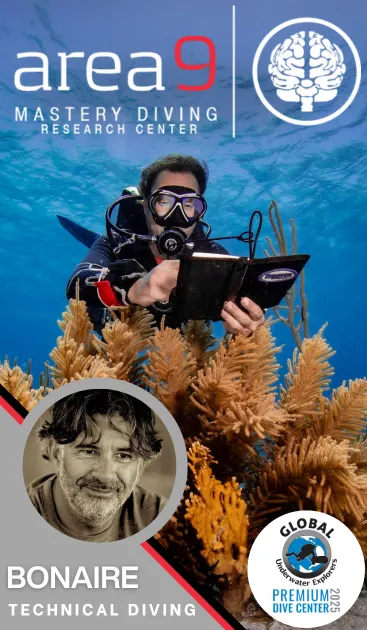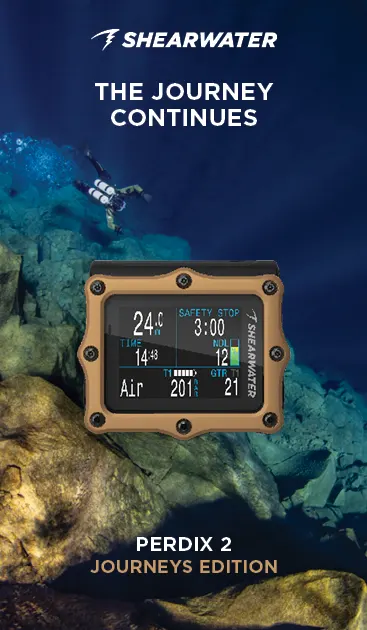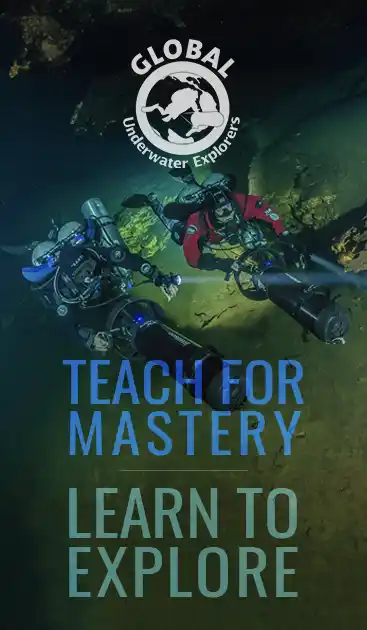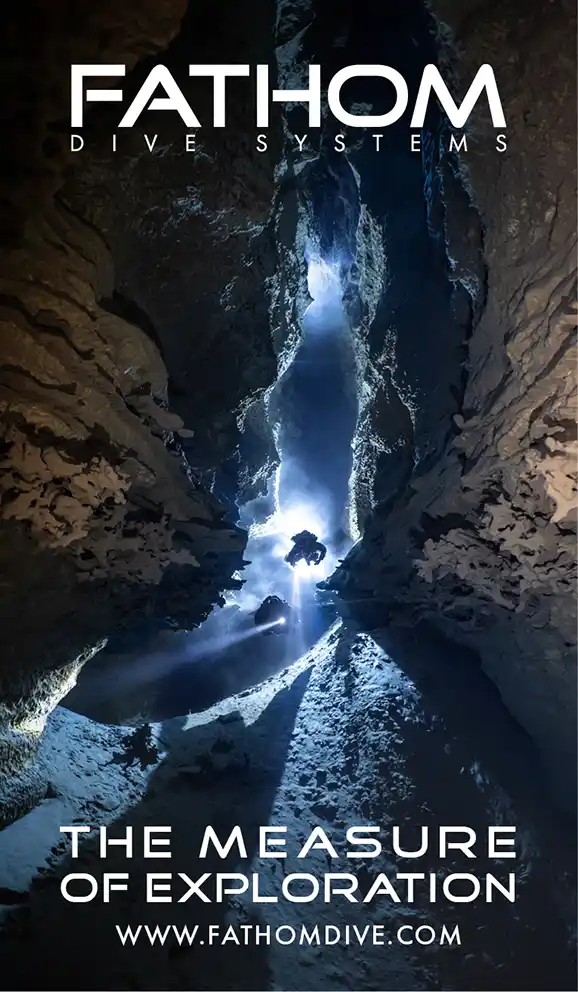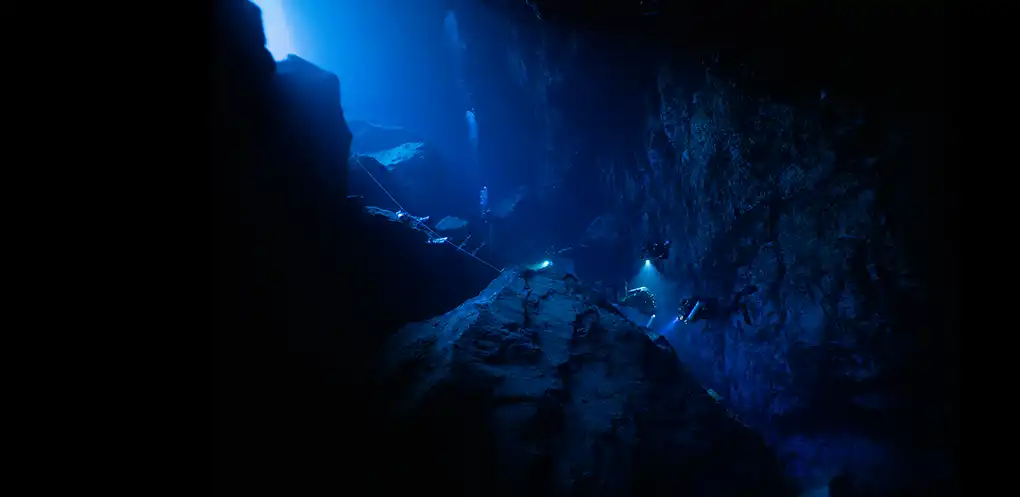
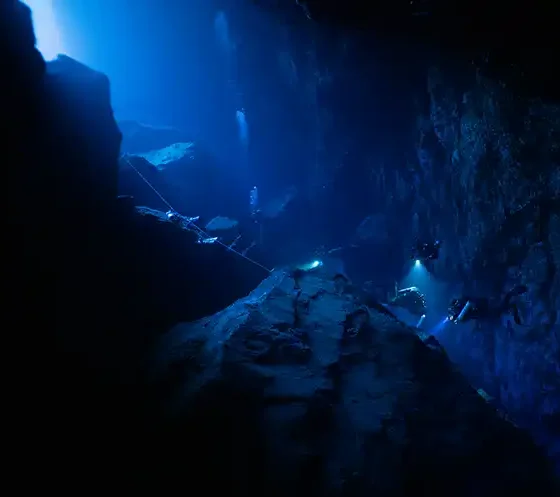
Latest Features
Cave Biology: What Lives When Light Ends
Beneath Florida’s bright waters, biologist and cave diver Tom Morris has spent a lifetime uncovering the secret ecosystems that thrive in eternal darkness — where evolution has crafted beings as strange as they are fragile.
By Marysia Trepat Borecka MSc
Lead Image: Lake Vouliagmeni, Greece — a hypersaline karst lake hosting the endemic sea anemone Paranemonia vouliagmeniensis, a species found nowhere else in the world. Photo by Carolin Negrin
When he was a kid, Tom Morris’s parents gave him a book called “The Life of the Cave” by Charles E. Mohr and Thomas L. Poulson [1]. Pictures of the mystical inhabitants of the underground world filled the book and made him dream of the life hidden just a few miles away from his home in Florida. In the 60s, Tom began exploring the intricate passages running under the sunny land of the Floridian peninsula, and he has not stopped since.
“When I first started cave diving—and I suspect this was the case for most people—I was paying a lot of attention to my own diving skills. You’re in a cave environment where you could potentially get yourself killed if you’re not careful, so you’re really paying a lot of attention to the diving part. But once it becomes a second nature, then the rest of the underground world really starts unfolding.”
During his career, he has explored and studied countless caves across the US and Mexico as a biologist, a cave diver, an explorer, a filmmaker, a book writer and an advocate. When he dives, he is fully aware of everything around him, taking mental notes of water movement, organic accumulations, and animal locations and abundances—observations he later records and that have become valuable data to multiple scientific papers (e.g. “Review of biologically significant caves” by Richard Franz) [2]. He can even take pride in having a cave crayfish species named after him: Procambarus morrisi, one of the many species he helped discover. Over the years, he has also trained some of his long term diving buddies to be able to see caves through the eyes of a biologist. Now, where most people see silent cathedrals of stone, they see a vibrant universe, a living world with fascinating biodiversity and the most inconceivable adaptations.
“One time, I was down diving solo in the eastern mountains of Mexico, in a cave connected to a thermal spring, and I came across a blind catfish. It was behaving so oddly that I thought that maybe he was sick, so I put him in a milk jug and I managed to get him all the way back to Florida alive. It turned out that it was a new species of cave catfish, one that had never been seen before!”
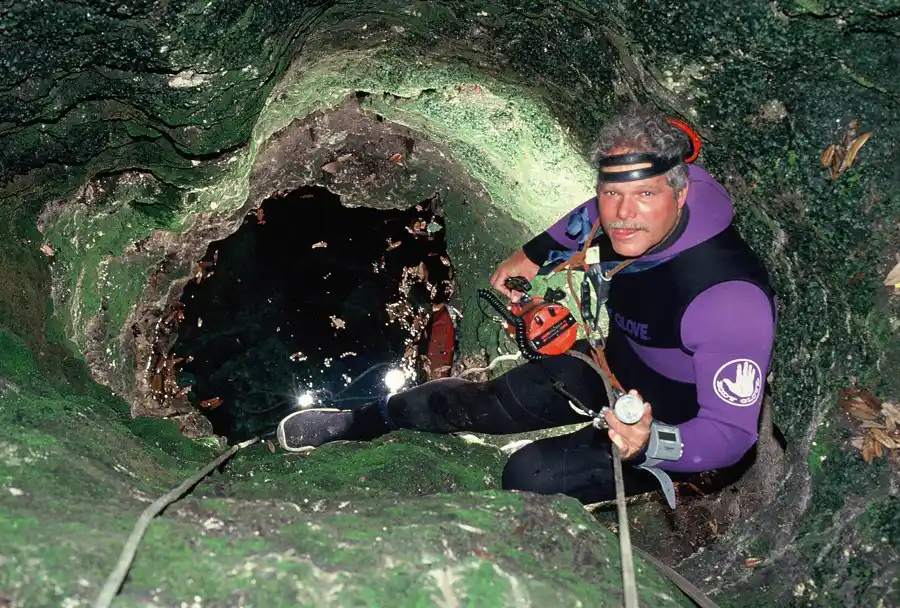
The place where light ends
Biospeleology—or cave biology—was born back in the 19th century in Postojna, a vast karst system in Slovenia, and one of the underground networks with the highest recorded biodiversity worldwide (116 cave-dwelling species described so far). It all started with the discovery of the narrow-necked blind beetle (Leptodirus hochenwartii), the first cave creature ever described [3]. Before that, it was believed that life could not exist in this kind of environment. Yet, caves have long stirred our imagination, appearing in legends and tales across cultures as mysterious thresholds to another world.
Postojna itself is home to the olm (Proteus anguinus), an eccentric-looking aquatic salamander that sporadically would get flushed out by storms, and that locals believed was a baby dragon.
It is no surprise that these unearthly labyrinths inspired scientists to choose evocative names for their inhabitants, such as the old scientific name of the Georgia blind salamander Haideotriton (so “salamander from Haides”, the realm of the dead) wallacei; or the widemouth blindcat, a catfish from Texas with scientific name Satan eurystomus. Even in the modern era, part of the magic that keeps drawing scientists and explorers like Tom Morris into these inhospitable depths is that they remain one of the planet’s least explored realms: a place where new species are still constantly being discovered, and where nature continues to puzzle even the experts.
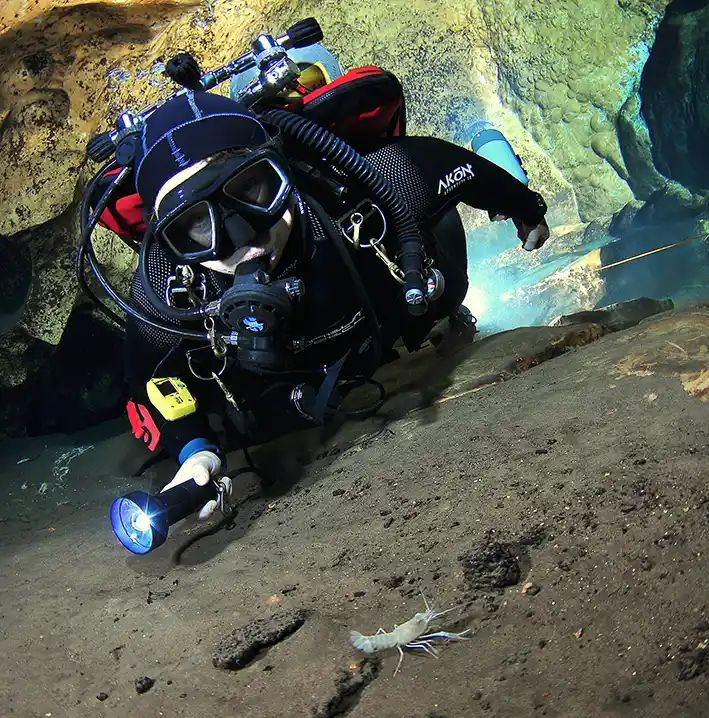
Caves are unique environments for many reasons. The obvious one is that there is no light, a simple factor that explains many of the adaptations found in their inhabitants. Take eyesight, for instance: in most animals adapted to life underground, eyes form early in the embryonic development but then gradually degenerate and eventually disappear as the embryo grows [4]. Researchers studying the Mexican tetra (Astyanax mexicanus), a blind cave fish, estimated that eyes alone can consume between 5-15% of your energy budget [5]. In a place where food is scarce, this is too high of a cost to spend in a structure that is not needed, so natural selection gradually eliminates them over evolutionary time. This selection force is so powerful that, in fact, the same adaptation has been found in some fish living deep in the Amazon river, where visibility is near zero [6]. Something similar happens with pigmentation: the proteins needed to make pigments are expensive to produce, but useless in a dark environment, and so cave-dwelling creatures also lack pigmentation.
“We never really think much about it, but in most animals, our superficial cells respond to light. Because of that, almost all animals—even the ones that went into caves—have circadian rhythms. But there’s a cavefish in Somalia, Garra andruzzii, whose cells have completely lost the reaction to light, and its circadian rhythm is 47 hours long.” [7]
Editor’s note: circadian rhythm is an internal clock that regulates behavior and physiological functions, such as sleep, hunger, and hormone release, usually following a 24-hour cycle
A lack of light is a limiting factor for some organisms, such as the plants and algae, which are confined to the daylight zone because they depend on photosynthesis to survive. However, that same lack of light can be an advantage for other organisms. Darkness is used by many species to avoid those predators that rely on sight to hunt. Catfish, for example, often pass time inside caves during the daytime but come out after dusk to feed—now safely—in the spring.
Another important characteristic in caves is the limited food supply, which also forces its inhabitants to be creative and look for sustenance in the most unsuspected places. Many rely on organic matter that washes underground through the cave entrance. Others may feed on other animals’ feces, such as bats or catfish, which can go deeper into the caves and become a very important part of the food supply.
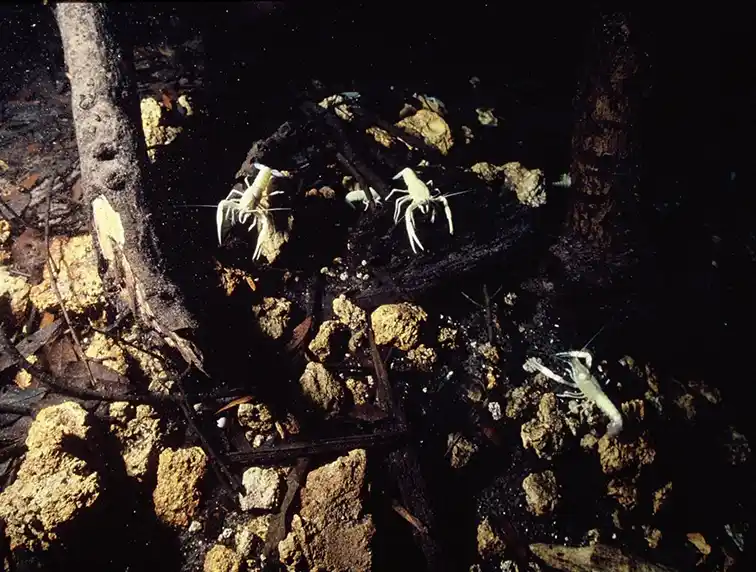
“Near my house, there’s a cave called Devil’s Eye, which is an oligotrophic cave (so food is very scarce). But there’s a room where catfish hang out during the day, called the Cat Scat Room. The fish defecate there, and their feces (scat) is a rich food resource. I can always find cave animals at this energy hotspot.”


Some species go even further and rely on far more unconventional food sources, such as chemosynthetic bacteria, i.e. microbes capable of producing organic matter and energy from inorganic chemical reactions (as opposed to photosynthesis, which uses light). Among them there is a group that can oxidize hydrogen sulfide, which is common in many underground environments, all the way to sulfuric acid. Remarkably, this acid can dissolve limestone, and so these microscopic creatures are capable of shaping and expanding the underground passages where they live in a process called Sulfuric Acid Speleogenesis [8]. Furthermore, recent studies proved that these same rock-carving bacteria—along with other chemosynthetic microbes—can become the foundation of an entire food web, similar to plants in terrestrial ecosystems [9]. Interestingly, there is a cave-dwelling fish, the Atlantic molly (Poecilia mexicana), that manages to survive and thrive in a hydrogen sulfide rich cave in Tabasco, Mexico, enduring concentrations that would be lethal to almost all other vertebrates.
“There’s one cave I know that has sulfur seeps back in the cave. There’s some little bitty seeps that come out of the organic silt and run down the hills, and you get sulfur oxidizing bacteria on it. And that’s where I find copepods. So whenever I find bacterial accumulations, I check those out very carefully.”
Editor’s note: copepods are a group of tiny and translucent crustaceans.
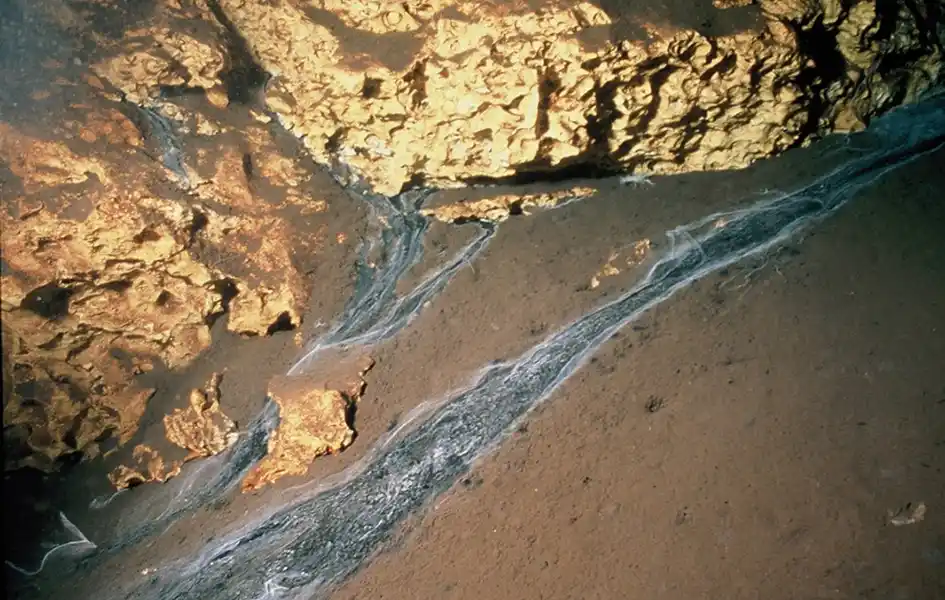
All in all, no food source is too small or too strange, and life has been able to colonize even the deeper parts of the caves, places where organic matter inputs from the rivers or the sea never reach. Yet, food generally remains scarce, and so survival depends on using these limited resources efficiently. For example, in an experiment conducted in the olm (Proteus anguinus), scientists saw that during the time when food is scarce, these salamanders can remain completely still for months at a time in order to preserve as much energy as possible until more nutrients arrive [10]. In most cases, species have evolved to possess low metabolic rates, a strategy that cuts down their energy needs with an unexpected beneficial side-effect.
“One of the things we’ve noticed with many cave animals is that they can have very extended lifespans compared to the animals that were their surface ancestors, and the reason for that is attributed to a very limited food supply. So their lifestyle slows down, their metabolic rates slow down, and their life is extended.” Tom Morris
Live beyond the beam
But what exactly lives down there? Most divers have noticed the typical fish wandering inside, usually following the beam of their torch, or the occasional shrimp peaking out of rocks and crevices, but that is only a small fraction of the biodiversity we can find. As Tom says “The longer you dive in caves, the more you become aware of other stuff. It’s just a matter of awareness and training.”
Cave-dwelling animals can be divided into three groups:
- Trogloxenes, or cave guests, are just visitors: species that regularly go in and out of the caves and are not able to survive living exclusively there. It is the case of bats or swiftlets, small birds found in tropical and subtropical regions that nest in caves and navigate them using echolocation. Snakes, frogs, and some fish also fall into this category. They tend to stay near the entrance but sometimes can venture far deeper (Tom recalls an occasion when he found a yellow bullhead catfish 85 m/280 ft deep and 1220 m/4000 ft back in Wakulla Springs, Florida).
- Troglophiles, literally “cave lovers,” can complete their life cycles both inside or outside the caves. They do not depend on these environments, and therefore lack the extreme adaptations of truly cave-bound species. On land, this group includes, for instance, cave crickets, millipedes, or pseudoscorpions; while underwater, it is mostly salamanders and certain species of fish.
- Troglobites (air-dwellers) and stygobites (water-dwellers) are the true cave specialists, creatures that cannot survive outside them. These include various fish, crayfish, isopods (a highly diverse group of crustaceans that includes the woodlice), shrimp and salamanders, among others. Trapped in there, they have evolved remarkable adaptations allowing them to thrive in these environments, such as blindness, lack of pigmentation, and slow metabolism, all mentioned before, but also an elongated body to slip through narrow passages, and highly developed sensory organs to navigate and hunt in the darkness.
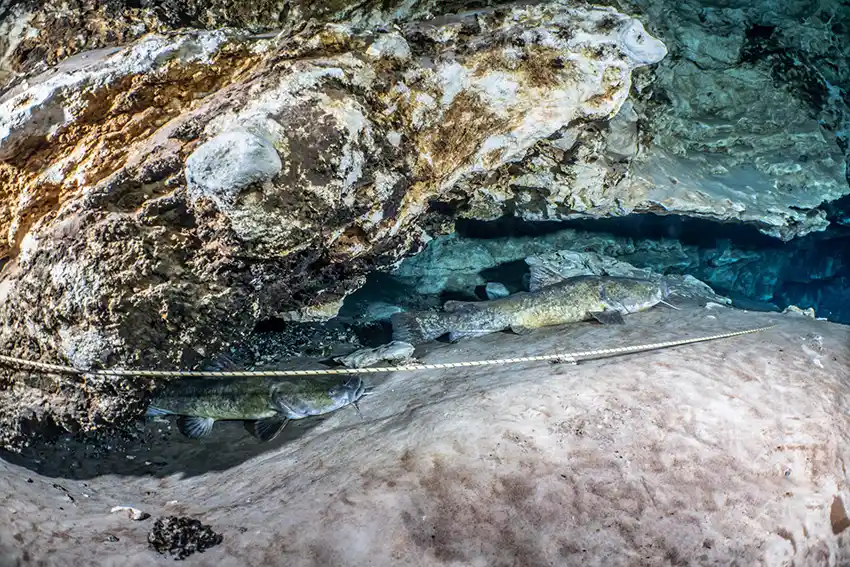
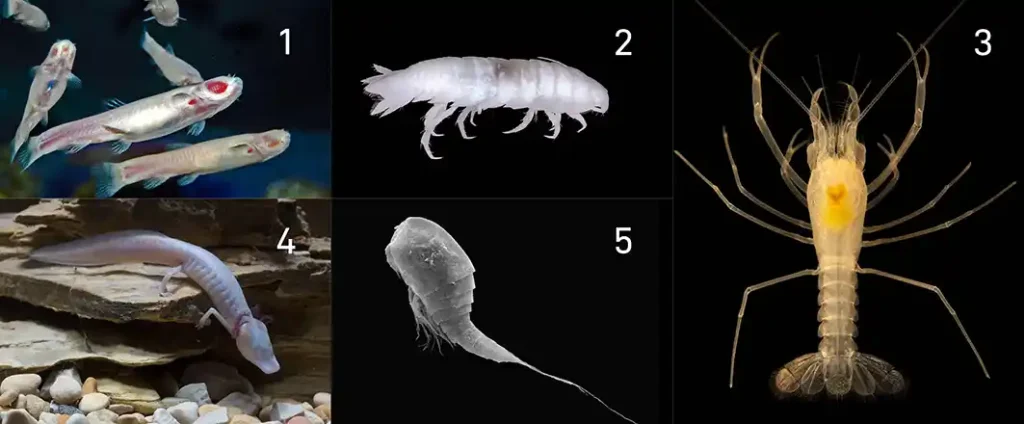
“I think my favorite cave organism is the North Florida Spider Cave Crayfish (Troglocambarus maclanei). This is the most wildly cave-adapted crayfish of all the crayfish in the world. They are white and blind. Their legs are extremely long, that’s why they are called the Spider Cave Crayfish. Their antennae are approximately three times as long as their bodies. And these antennae are, of course, how they feel their way around the cave environment. They’re beautiful little things, no more than a couple of centimeters long at most, and they’re so delicate. So I’m really fond of that little animal.”
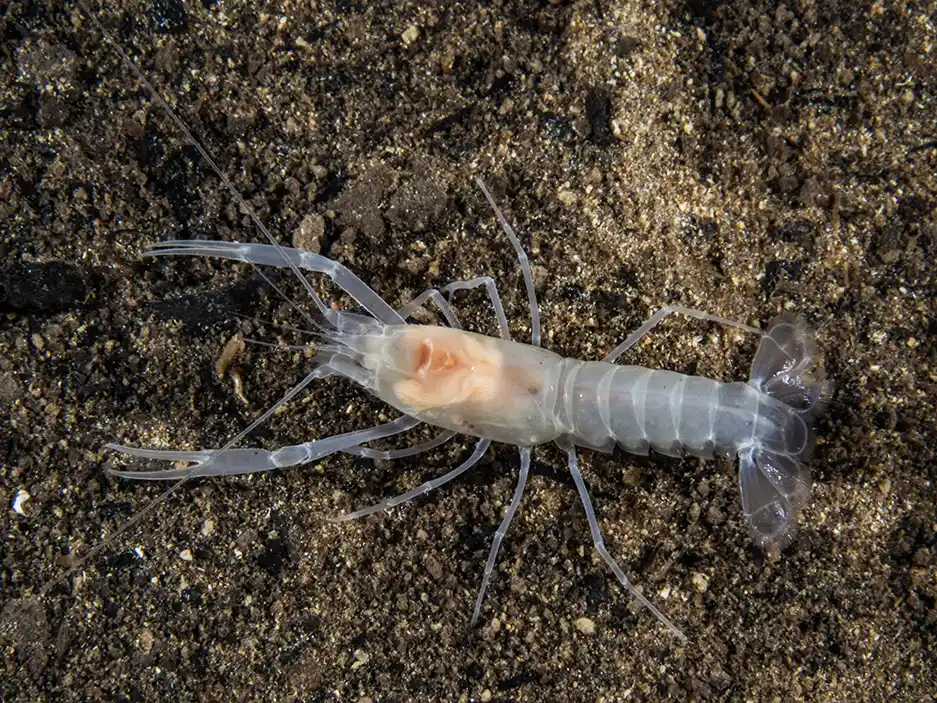
Many troglobites and stygobites evolved from groups that were already pre-adapted to life in the darkness, which eased their transition into cave environments. Take crayfish, for instance, which are an important part of Florida’s stygobitic fauna. Many of the surface species live at least part of their lives in burrows, where conditions are similar to those in caves. The most extreme among them, the burrowing crayfish, even spend their whole lives within the tunnels they build. This pre-adaptation to darkness probably helped the ancestors of stygobitic crayfish to colonize cave passages.
What is most surprising is that, although caves are typically food-poor environments – which should limit the species richness they can sustain (i.e. number of species) – many of them still host much more life than expected. The Edwards Aquifer in Texas, for example, is home to over fifty highly adapted aquatic species, making it one of the richest aquifers in North America in terms of stygobitic fauna [11]. Part of this diversity comes from the stability of the environment, which helps to increase the number of species that can live there. This pattern has also been observed in the deep sea, another dark and nutrient-poor habitat that, regardless of that, supports a surprisingly rich ecosystem.
The darkness we must protect
Permanent cave inhabitants tend to have very limited distribution ranges, to the point that sometimes they are confined to a small handful of systems or chambers. This is because most species are endemic, i.e. they are native and only found in a single reduced area. When populations of a species are separated, the gene flow between them stops because there is no reproduction, and so they start diverging and eventually become two different species. Caves, with their unique conditions, act as natural barriers for cave-adapted organisms, making them the perfect setting for this kind of speciation process. As a result, the endemism in these systems is extraordinarily high, with each one of them sometimes hosting lineages found nowhere else in the world. So when you spot a small copepod or a translucent shrimp drifting in the beam of your light, chances are you’re looking at something truly rare.
“Here in Florida, we have 17 species of cave-adapted crayfish. Six of those species occur in one site only, two in only two sites, and then four in less than six sites so there’s this high degree of endemism which means we’ve really got to look at these guys and take care of their habitats.” Tom Morris [2]
In fact, one of the biggest problems faced by cave fauna is having such limited distribution ranges—any disturbance could be fatal and push them towards extinction. Tom has witnessed this firsthand: back in the 90s he was hired to check on the status of a stygobitic shrimp that was known to live exclusively in one spot, only to find that the species had vanished, probably wiped out by a little spring chub that ventured randomly into its habitat and managed to prey on the entire population, wiping it out. In fact, for the IUCN—the main international authority on wildlife conservation, and author of the famous “Red List of Threatened Species”—the size of a species’ range is an essential criteria to assess their risk of extinction. As a result, many troglobites and stygobites can be frequently found in international lists of endangered animals. Additionally, cave food webs tend to be relatively simple, with each species preying on few species (what is called little “redundancy”), and so when one disappears, it will probably have cascading effects across the entire ecosystem. In other words, in these realms, every life form is a crucial piece of the puzzle.
Moreover, most of the world’s aquifers are currently under serious threat from over-pumping (i.e. we extract groundwater so fast that nature cannot replenish it) and pollution (if you are interested to know more, you can read the testimony of Tom Morris in the episode of The Talks: Take Only Ghost Nets, Leave Only Karst, rrr Coral? And What About the Water?).
In Florida, as in many aquifers located within or near agricultural regions, the main problem is nitrate pollution from fertilizers, which can damage aquatic life in multiple ways. For example, in creatures like crayfish, studies have shown that elevated nitrate levels can impair their ability to get oxygen from the water, which in an oxygen-poor environment can be devastating for their survival [12].
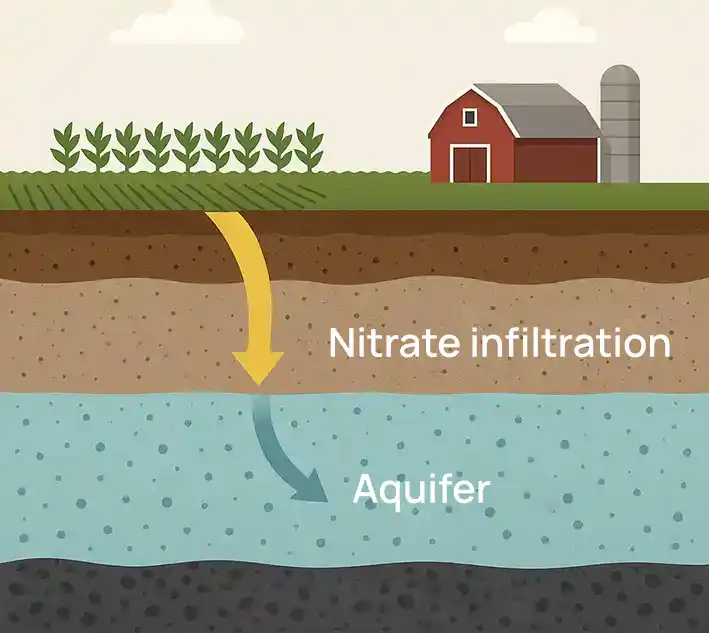
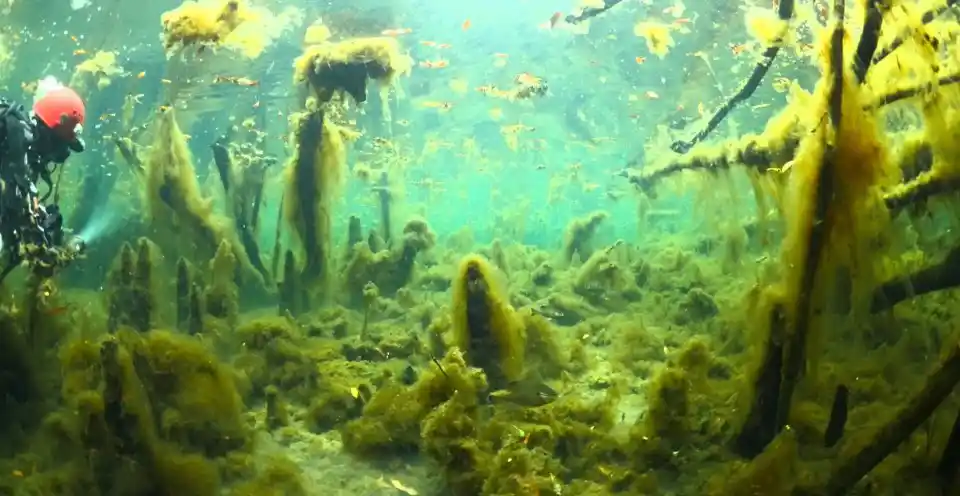
“Before, nitrates coming out of our springs and wells was almost not measurable. Now we get numbers like two parts per million and some places all the way up to 30 parts per million [13]. The drinking water standard is 10 parts per million [14]. They don’t recommend drinking any more than that.”
For some species, even the slightest disturbance can cause harm. The bubbles produced by open-circuit divers, for example, can erode the microbial mats that coat the ceilings and walls of some caves. These mats generally have slow growing rates, meaning recovery can take years in some cases. Additionally, a study carried out in Florida’s Little Springs River showed that the heavy traffic of open-circuit divers can double or even triple-fold the oxygen levels in the water, which can be detrimental to organisms adapted to low-oxygen conditions [15]. These issues can be avoided using rebreathers, which play an important role in diving these delicate environments while minimizing disturbance.
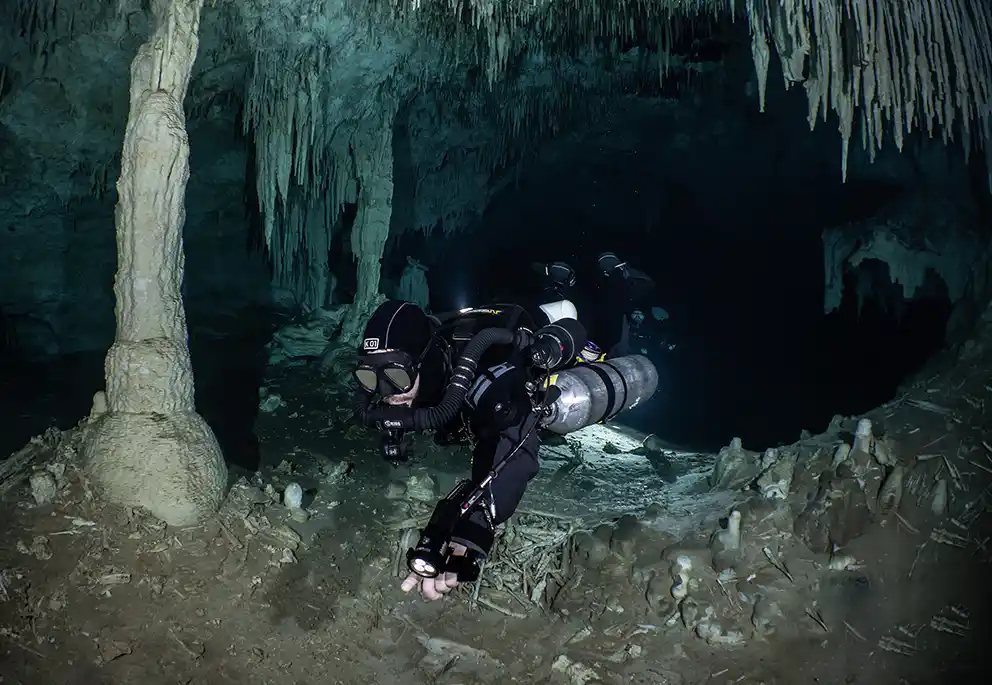
Scooters, however, pose another risk, as their propellers can shred the small animals suspended in the water column. For this reason, Tom does not allow their use inside Thunderhole, the cave he owns in northern Florida. However, in most systems, the impacts of cave diving remain limited to a small fraction of their passages, and so the real threats come from the broader pressures mentioned previously. As a matter of fact, cave divers are one of the strongest allies of biospeleologists. They play a critical role by mapping submerged passages, collecting data and samples, and even discovering new species.
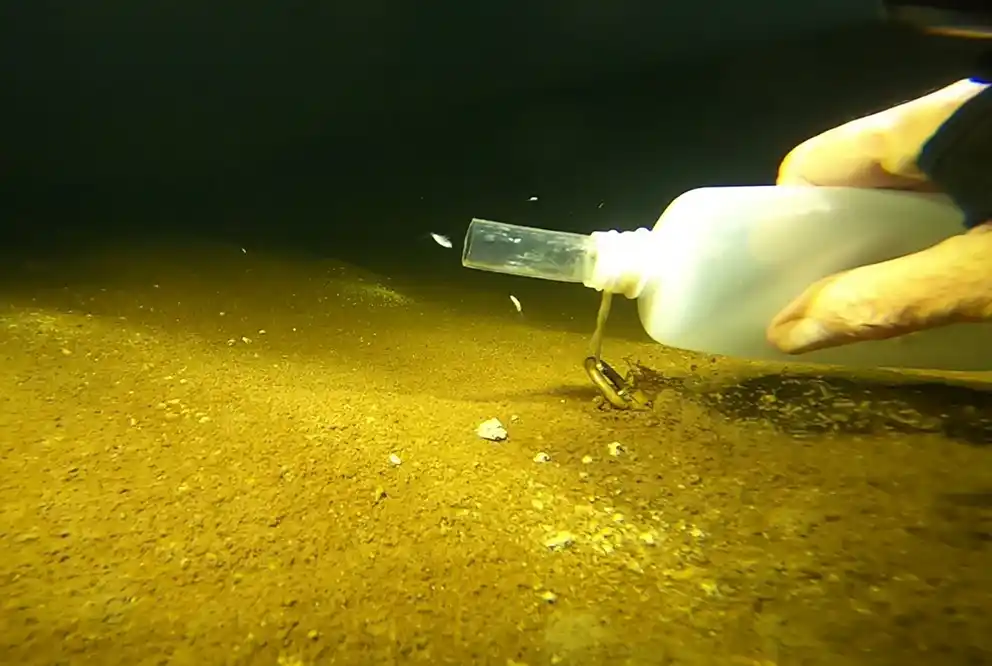
“Cave divers are really critical for telling us about life in the caves. Here in Florida, before cave diving, if you went looking around sinkholes maybe you could find some cave-adapted crayfish near the surface. You could also lower traps or even use nets to try to catch them, but a lot of these creatures do not come to traps, even if baited. So the only way to survey them is to dive into their habitat.”
“In fact, several of the crayfish in Florida are named after cave divers who found them, so the cave divers have had a big role in describing the cave fauna.” Tom Morris
The mystery that remains
As diving equipment continues to advance, our ability to explore and understand caves grows with it. “The future looks good, we now have more equipment than we ever had before for exploring the underground world. We can get in further, stay longer, and do it safer” Tom says. He believes that these technological advances will lead to new discoveries and will also help to solve old mysteries. In recent years we’ve also made some major breakthroughs in the world of science, such as the invention of environmental DNA (eDNA), a technique that allows identification of the species present in a cave by analyzing the genetic traces they naturally leave behind.
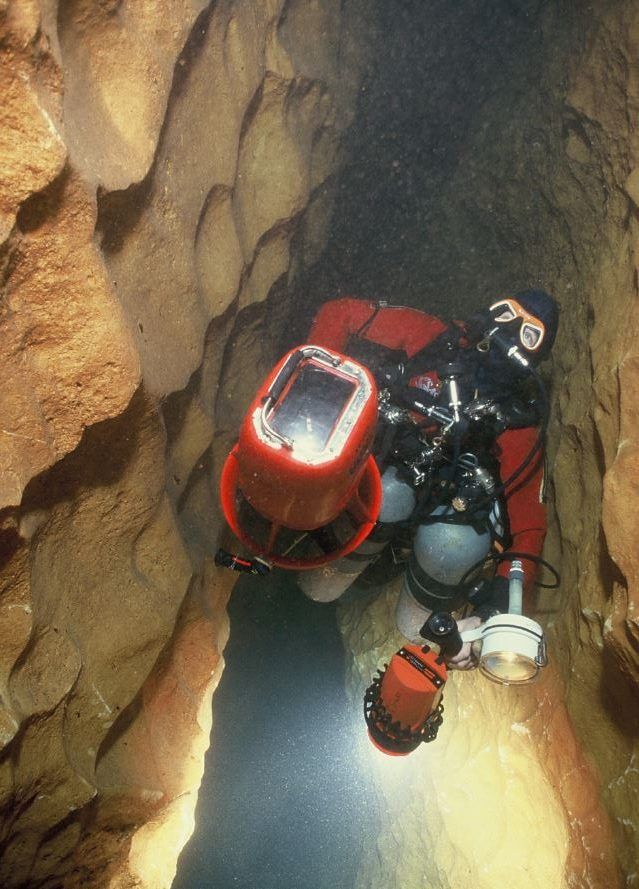
Tom will follow all these advances closely. With a career in biospeleology of more than four decades, he remains curious. He still reacts eagerly at every opportunity to descend into the dark realm he knows so well, drawn by the same fascination that first led him to the underwater world.
“I would love to go underwater and see the olm (Proteus anguinus) from Slovenia. That salamander is just so wild looking: the eyes are gone, they’re super pale. They’re the superstar of cave animals.” In the end, that sense of awe–shared by scientists and divers alike–is what keeps drawing us to these hidden labyrinths, untouched by the warmth of the sun: a reminder that life still has the power to surprise us. “These are the kind of things that keep the interest, right?” Tom adds with a smile “You always want mysteries.”
References:
- Mohr, C. E., & Poulson, T. L. (1966). The life of the cave. McGraw-Hill.
- Franz, R., Bauer, J., & Morris, T. (1994). Review of biologically significant caves and their faunas in Florida and South Georgia. Brimleyana, 20, 1–109.
- Zagmajster, M., Polak, S., & Fišer, C. (2021). Postojna-Planina Cave System in Slovenia: A hotspot of subterranean biodiversity and a cradle of speleobiology. Diversity, 13(6), 271. https://doi.org/10.3390/d13060271
- Krishnan, J., & Rohner, N. (2017). Cavefish and the basis for eye loss. Philosophical Transactions of the Royal Society B: Biological Sciences, 372(1713), 20150487. https://doi.org/10.1098/rstb.2015.0487
- Moran, D. (2015). The energetic cost of vision and the evolution of eyeless Mexican cavefish. Science Advances, 1(10), e1500363. https://doi.org/10.1126/sciadv.1500363
- Carvalho, T. P., Reis, R. E., & Sabaj, M. H. (2017). Description of a new blind and rare species of Xyliphius (Siluriformes: Aspredinidae) from the Amazon Basin using high-resolution computed tomography. Copeia, 105(1), 14–28.https://doi.org/10.1643/CI-16-456
- Cavallari, N., Frigato, E., Vallone, D., Fröhlich, N., Lopez-Olmeda, J. F., Foà, A., Berti, R., Sánchez-Vázquez, F. J., Bertolucci, C., & Foulkes, N. S. (2011). A blind circadian clock in cavefish reveals that opsins mediate peripheral clock photoreception. PLOS Biology, 9(9), e1001142. https://doi.org/10.1371/journal.pbio.1001142
- Engel, A. S., Stern, L. A., & Bennett, P. C. (2004). Microbial contributions to cave formation: New insights into sulfuric acid speleogenesis. Geology, 32(5), 369–372. https://doi.org/10.1130/G20288.1
- Brad, T., Iepure, S., & Sarbu, S. M. (2021). The chemoautotrophically based Movile Cave groundwater ecosystem: a hotspot of subterranean biodiversity. Diversity, 13(3), 128. https://doi.org/10.3390/d13030128
- Balázs, G., Lewarne, B., & Herczeg, G. (2020). Extreme site fidelity of the olm (Proteus anguinus) revealed by a long-term capture–mark–recapture study. Journal of Zoology, 311(2), 99–105. https://doi.org/10.1111/jzo.12760
- Hutchins, B. T., Gibson, J. R., Diaz, P. H., & Schwartz, B. F. (2021). Stygobiont diversity in the San Marcos Artesian Well and Edwards Aquifer groundwater ecosystem, Texas, USA. Diversity, 13(6), 234. https://doi.org/10.3390/d13060234
- Gomez Isaza, D. F., Cramp, R. L., & Franklin, C. E. (2018). Negative impacts of elevated nitrate on physiological performance are not exacerbated by low pH. Aquatic Toxicology, 200, 217–225. https://doi.org/10.1016/j.aquatox.2018.05.004
- 13. Katz, B. G., DeHan, R. S., Hirten, J. J., & Catches, J. S. (1995). Nitrate in ground water and spring water near four dairy farms in north Florida, 1990–93 (U.S. Geological Survey Water-Resources Investigations Report 94–4162). U.S. Geological Survey. https://doi.org/10.3133/wri944162
- U.S. Environmental Protection Agency. (2022). National primary drinking water regulations (EPA 816-F-09-004). https://www.epa.gov/ground-water-and-drinking-water/national-primary-drinking-water-regulations
- 15. Butt, P. Personal communication. Karst Environmental Services.
Enjoyed this read? Here are more stories that tie into it.
DIVE DEEPER
InDEPTH: Take Only Ghost Nets, Leave Only Karst, rrr Coral? And … – by Tom Morris (2025)
InDEPTH: Help Save Mill Creek Sink! (2025)
InDEPTH: The Inimitable Wes Skiles (2022)
Science Direct: Ghost fishing gear and their effect on ecosystem services – Identification and knowledge gaps by Huu-Luat Do, Claire W. Armstrong (2023)
BMC: Environmental specificity of karst cave habitats evidenced by diverse symbiotic bacteria in Opiliones Zhao, L., Xiao, R., Zhang, S. et al. (2023)
BBC Earth: The Murky World of Cavefish by Prosanta Chakrabarty
Hakai Magazine: The Cavernous World under the Woods by Larry Pynn (2018)
Earth Matters (New Mexico Bureau of Geology): New Mexico’s Sulfuric Acid Caves by Daniel Jones, Victor Polyak, Harvey DuChene, and George Veni (2022)

Tom Morris is an ecologist with degrees in Wildlife Biology and Botany. He grew up swimming and diving in Florida’s springs since about 1960, and has witnessed the general decline in their health. His cave diving hobby blended nicely with his biological career, and he considers himself lucky to have been able to explore and study what were the almost entirely undescribed groundwater ecosystems in Florida and, to a lesser degree, Mexico. Tom has a background in water resource studies, having worked at Florida’s St. John’s River Water Management District and the Center for Wetlands Research at the University of Florida. He worked for several decades at Karst Environmental Services, a small company specializing in groundwater and biological resource studies. In the early 80’s Tom started diving with Wes Skiles and they became lifelong diving partners.Tom got to join Wes on his filmmaking career, and helped film many documentaries, including an IMAX film and National Geographic and NOVA specials, involving springs and caves in several countries, which always emphasized the protection of natural resources. Karst Environmental Services has recently shut down, but Tom continues his studies of Florida’s groundwater ecosystems, focusing on its rich troglobitic fauna.

Marysia Trepat Borecka is a biologist and ecologist with a lifelong love for the sea and nature. She began exploring the underwater world as a diver during her university years, combining her scientific training with her love for discovery. Her professional experience includes research on marine ecology and field experiences across Europe and South America, where she contributed to projects focused on biodiversity protection. Marysia is passionate about conservation and science communication, thrives in multidisciplinary environments, and is committed to building bridges between research and community to protect our natural world for future generations.






